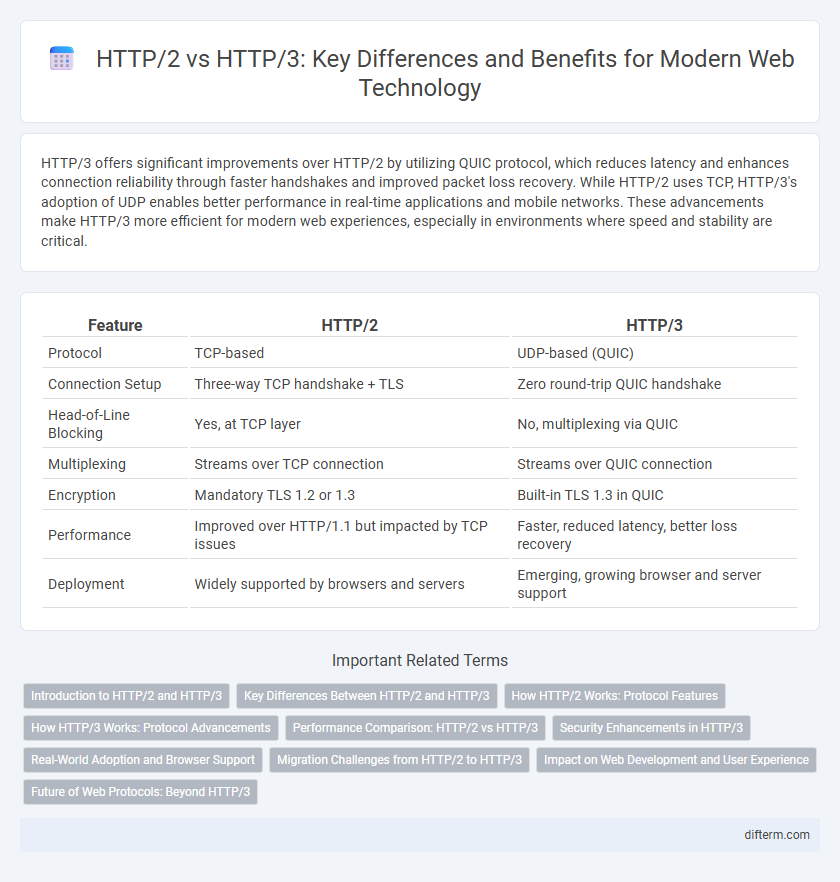HTTP/3 offers significant improvements over HTTP/2 by utilizing QUIC protocol, which reduces latency and enhances connection reliability through faster handshakes and improved packet loss recovery. While HTTP/2 uses TCP, HTTP/3's adoption of UDP enables better performance in real-time applications and mobile networks. These advancements make HTTP/3 more efficient for modern web experiences, especially in environments where speed and stability are critical.
Table of Comparison
| Feature | HTTP/2 | HTTP/3 |
|---|---|---|
| Protocol | TCP-based | UDP-based (QUIC) |
| Connection Setup | Three-way TCP handshake + TLS | Zero round-trip QUIC handshake |
| Head-of-Line Blocking | Yes, at TCP layer | No, multiplexing via QUIC |
| Multiplexing | Streams over TCP connection | Streams over QUIC connection |
| Encryption | Mandatory TLS 1.2 or 1.3 | Built-in TLS 1.3 in QUIC |
| Performance | Improved over HTTP/1.1 but impacted by TCP issues | Faster, reduced latency, better loss recovery |
| Deployment | Widely supported by browsers and servers | Emerging, growing browser and server support |
Introduction to HTTP/2 and HTTP/3
HTTP/2, introduced in 2015, enhanced web performance by enabling multiplexing, header compression, and server push, reducing latency compared to HTTP/1.1. HTTP/3 builds upon HTTP/2's improvements by utilizing QUIC, a transport protocol based on UDP, which offers faster connection establishment and improved reliability in packet loss environments. The adoption of HTTP/3 significantly improves web browsing speed and security through integrated TLS encryption and reduced handshake overhead.
Key Differences Between HTTP/2 and HTTP/3
HTTP/3 introduces QUIC, a transport protocol built on UDP, replacing TCP used in HTTP/2, significantly reducing connection and transport latency. Unlike HTTP/2, which relies on a single TCP connection that can suffer head-of-line blocking, HTTP/3's multiplexed streams over QUIC eliminate this issue, enhancing data transmission efficiency. Enhanced security is embedded in HTTP/3 as encryption is mandatory in QUIC, while HTTP/2 supports optional encryption through TLS.
How HTTP/2 Works: Protocol Features
HTTP/2 improves web performance by multiplexing multiple requests and responses over a single TCP connection, reducing latency and enhancing resource utilization. It introduces header compression using HPACK, which minimizes overhead by efficiently encoding HTTP headers. Stream prioritization and server push further optimize content delivery, allowing faster and more efficient loading of web pages compared to HTTP/1.1.
How HTTP/3 Works: Protocol Advancements
HTTP/3 operates over QUIC, a transport protocol built on UDP that reduces connection latency and improves multiplexing by eliminating head-of-line blocking present in HTTP/2's TCP-based connections. It integrates TLS 1.3 encryption directly into the transport layer, accelerating handshake and enhancing security by combining encryption and transport protocols. These advancements enable faster, more reliable data transfer for modern web applications, especially under conditions of network congestion and packet loss.
Performance Comparison: HTTP/2 vs HTTP/3
HTTP/3 significantly outperforms HTTP/2 in latency reduction and connection reliability by utilizing QUIC protocol over UDP instead of TCP, minimizing handshake delays and improving packet loss recovery. Real-world tests show HTTP/3 decreases page load times by up to 20% under typical internet conditions, especially in high-latency and lossy networks. Enhanced multiplexing and header compression in HTTP/3 further optimize resource delivery, making it the preferred protocol for improved web performance.
Security Enhancements in HTTP/3
HTTP/3 significantly enhances security by integrating QUIC, a transport layer protocol built on UDP, which reduces connection latency and improves resistance to packet loss. This protocol encrypts all headers and data by default, eliminating vulnerabilities inherent in HTTP/2's reliance on TCP and TLS handshakes. Enhanced encryption and faster handshake processes in HTTP/3 provide robust protection against eavesdropping and man-in-the-middle attacks, improving overall web communication security.
Real-World Adoption and Browser Support
HTTP/3 adoption has accelerated due to its use of the QUIC transport protocol, offering faster connection establishment and improved performance in real-world applications compared to HTTP/2. Major browsers like Chrome, Firefox, Edge, and Safari now support HTTP/3, enhancing compatibility across diverse devices and networks. Despite its growing popularity, HTTP/2 remains widely deployed, especially on legacy systems and enterprise environments where compatibility is critical.
Migration Challenges from HTTP/2 to HTTP/3
Migrating from HTTP/2 to HTTP/3 presents challenges rooted in the fundamental protocol differences, such as the shift from TCP to QUIC, which requires updated network infrastructure and compatibility adjustments. Implementing HTTP/3 demands extensive testing to ensure seamless transition without disrupting existing services due to varying browser and server support levels. Security configurations and performance tuning must be carefully managed to leverage HTTP/3's advantages in connection establishment and multiplexing while maintaining backward compatibility with HTTP/2.
Impact on Web Development and User Experience
HTTP/3 introduces QUIC protocol that reduces latency and improves connection reliability compared to HTTP/2's reliance on TCP, significantly enhancing page load speeds and real-time web applications. The adoption of HTTP/3 enables developers to optimize performance through multiplexing without head-of-line blocking, resulting in smoother streaming, faster secure connections, and better support for mobile and flaky network conditions. User experience benefits from decreased buffer times and improved responsiveness, driving higher engagement and retention in web applications.
Future of Web Protocols: Beyond HTTP/3
HTTP/3 leverages QUIC, a transport protocol that reduces latency and improves connection reliability compared to HTTP/2's reliance on TCP. Future web protocols aim to further enhance performance by integrating features like encrypted DNS, enhanced multiplexing, and adaptive congestion control. Emerging standards prioritize security, speed, and seamless user experiences as the foundation for evolving web communications beyond HTTP/3.
HTTP/2 vs HTTP/3 Infographic

 difterm.com
difterm.com